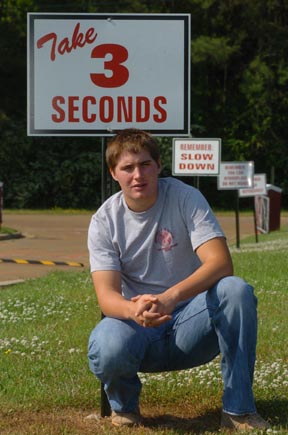JACKSON, Miss.—Slow down. Buckle your seatbelt. Drive defensively.
A row of warning signs remind Terry High School students to drive safely, but Jonathan Knight hardly needs the reinforcement. Every day the 16-year-old deals with the fallout from a Sept. 13 car wreck that collapsed both his lungs, damaged one kidney, broke his collarbone and severely bruised his brain.
He can’t play his favorite sport; doctors say baseball is too risky for a traumatic brain injury survivor. And he has found that class work isn’t the breeze it used to be.
“It was hard,” he says of his February return to school following months of therapy at Methodist Rehabilitation Center in Jackson. “I got a million hugs, though,” he adds with a grin.
The outpouring of affection is understandable, given Terry High School’s grim past. From 2001 through 2003, seven students died in their senior year, all victims of motor vehicle crashes. Like Jonathan, every last one had neglected to wear a seatbelt, said Dr. Stephen Handley, Terry High’s principal the past five years.
Talk around town was that the school was cursed, but Handley felt such carnage could be avoided if students felt it was “cool” to use seatbelts. So in fall of 2003, he began a passionate campaign to get kids to “take 3 seconds” to buckle up. “I didn’t want to go to any more kids’ funerals,” he said. “Our theme was every senior there on graduation night and everyone else there to watch them.”
Terry’s latest crop of seniors graduate May 24, and Handley is proud to say the school has gone almost two years without losing a student in a motor vehicle accident. And it may well be the result of Handley’s almost over-the-top tactics.
After enlisting the help of parents and community businesses, Handley pulled out all stops – including installing eight speed bumps in the parking lot. He also asks students to sign pledges promising to use seatbelts, hands out prizes to those who come to school buckled up and hovers at the exit of events like the prom to remind all to “take 3 seconds.”
At one of the school’s safety events, Handley also arranged for students to see a simulation of what can happen when a vehicle flips and the unbuckled occupants are sent flying. The demo uses dummies. But on the day of Jonathan’s wreck, a few of his buddies had the misfortune of watching the scenario happen to a human being.
As his Chevy Blazer tumbled across three lanes of traffic, Jonathan was tossed onto the roadside like a discarded cigarette butt. Fortunately, an ambulance crew witnessed the wreck and transported Jonathan to the University of Mississippi Medical Center in Jackson in record time.
“That was a miracle,” said his dad Mark Knight. “Both his lungs were collapsed and seconds were critical. The smoke hadn’t even cleared and there was the ambulance.”
After receiving news of the wreck via cell phone, his parents rushed to UMC in time to watch their battered son wheeled into the hospital. “They said it was touch and go and it could be weeks or months until he got out of the hospital and maybe years of recovery,” said his mom Janet Knight.
Jonathan has since defied those predictions. And his parents credit Methodist’s nationally recognized brain injury rehabilitation program with helping him beat the odds. “I had installed the nurse call system in the hospital and I knew the care there was outstanding,” said his dad, who worked at Sound and Communications at the time. “I said as soon as he gets out of the intensive care unit, I want him to get to Methodist.”
As one of only 16 Traumatic Brain Injury (TBI) Model System sites in the nation, Methodist plays a leading role in TBI research. And that involvement means that knowledge gained through research can immediately be applied to patient care, said Dr. Mark Sherer, project director of the TBI Model System of Mississippi.
Methodist also is home to Quest, Mississippi’s only comprehensive community re-integration program for brain injury survivors. And by November, Jonathan was ready to work with staff there on strategies to ease his transition back to school.
The school, in turn, collaborated with Quest to make the most of Jonathan’s return. “They’ve been very supportive,” said his mom. “They said if he needed extra help they would give it to him and they gave him an off period so he could rest.”
No one’s happier to see Jonathan back at school than Handley. “When his wreck happened, we were all devastated,” he said. “We had a prayer circle the night of the wreck. We knew if we supported him and his family enough, only good would happen. There’s no doubt God has a purpose for this young man.”
And the purpose may well be to serve as a flesh-and-blood reminder of how much a moment of recklessness can cost you. Jonathan’s friends have seen how disappointed he is that he can no longer play the sports he loves. “I know my friends don’t drive like they used to around me,” he said. “And when someone does, I say something.”

